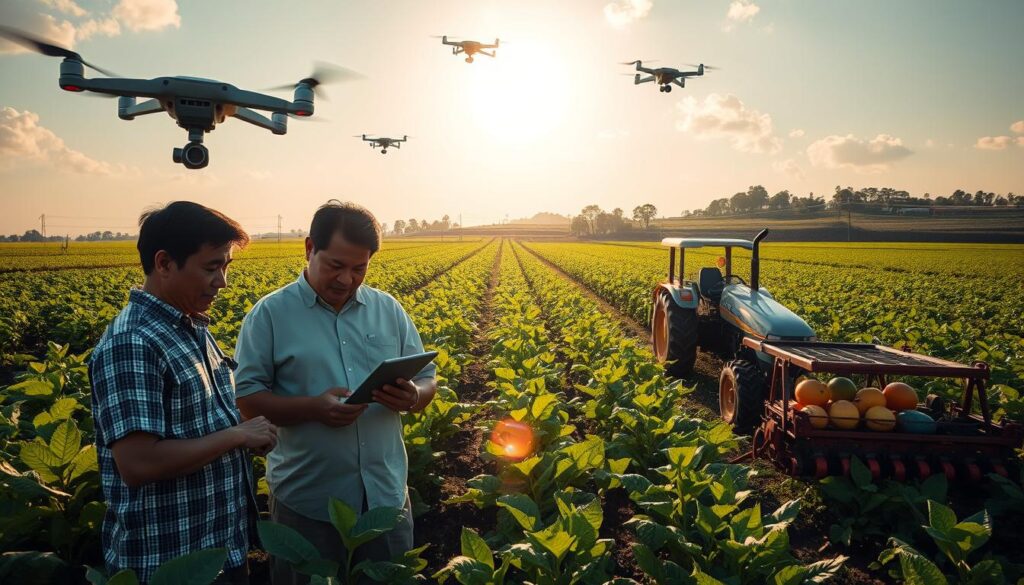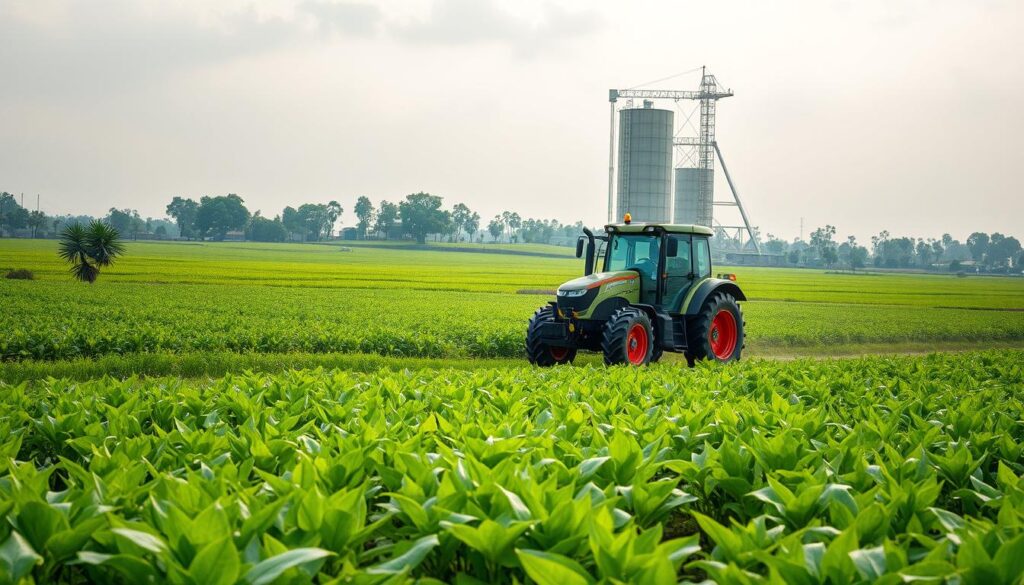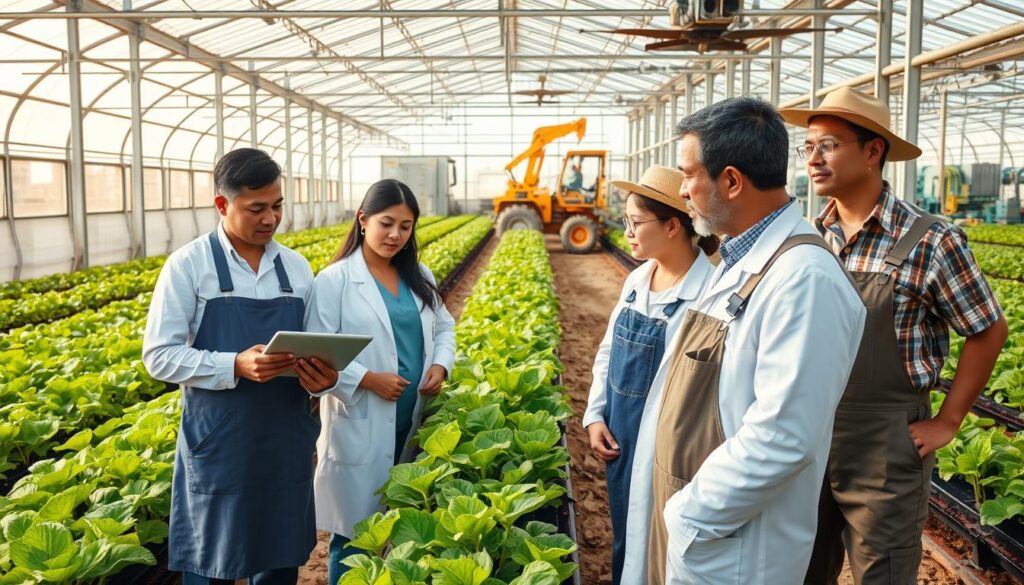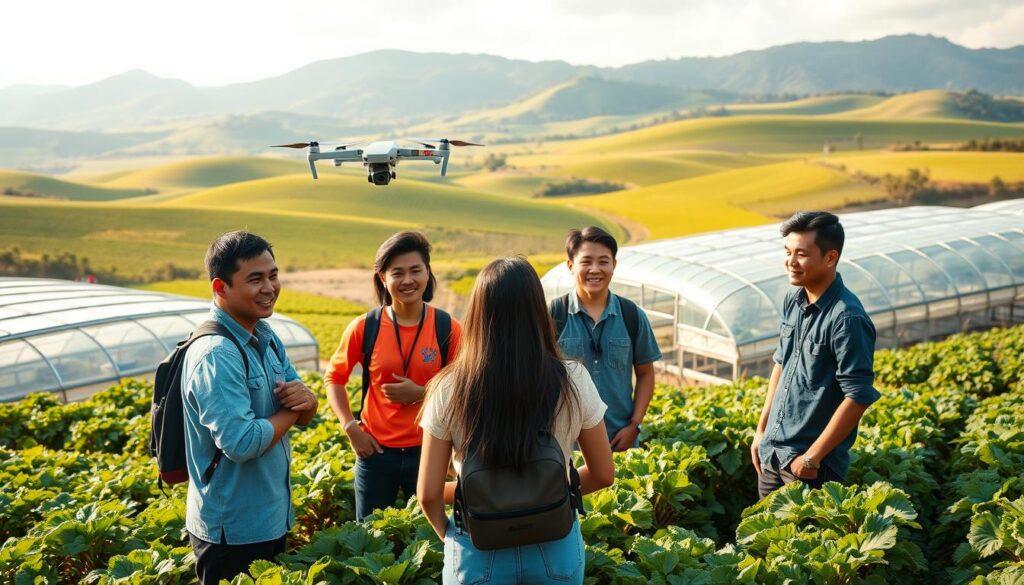As the world’s population is set to hit 10 billion by 2050, can we ignore AI’s power in farming? This tech is changing how we use our resources, boosting crop yields and saving resources. The agriculture sector must meet growing food needs and face challenges like climate change and water scarcity. AI is key to solving these problems.
AI brings predictive analytics and machine learning to farming. It lets farmers make smarter choices with data. AI helps farmers use drones for precise pesticide application, checks crop health, and offers insights to boost productivity and sustainability.
The AI in agriculture market is set to grow from ₱97.2 billion to ₱268.8 billion by 2028. This shows a surge in new solutions. Are you ready to see the future of farming?
Key Takeaways
- The global population may reach 10 billion by 2050, increasing agricultural pressure.
- The AI in agriculture market is expected to grow significantly, reaching USD 4.7 billion by 2028.
- AI can improve crop yields by up to 30% through advanced data analytics.
- Real-time insights from AI enable precise resource management and decision-making.
- AI technology effectively detects crop diseases and optimizes pesticide applications.
- Automated systems in agriculture enhance efficiency and reduce labor costs.
- AI experience can transform traditional farming methods into smart agriculture practices.
Understanding the Role of AI in Agriculture
AI in agriculture is a big step forward for farming. It uses smart machines to automate tasks and help farmers make better choices. By looking at lots of data, AI can predict how crops will do.
What is AI in Agriculture?
AI in agriculture uses data, models, and automation to help farming. It uses tools like sensors, drones, and satellite maps to get info on soil, weather, and crops. For example, the ‘Xarvio Field Manager’ from BASF helps predict weather, manage water, and figure out pesticide needs.
This helps farmers make smart choices and manage their farms better.
Key Benefits of AI for Farming
AI in farming brings many benefits, like saving money and being better for the environment. Farmers see their crops grow by up to 30% and spend 10-15% less on operations. AI helps use resources like water better, saving 20-30%.
It also cuts down pesticide use by 50%. These changes help farmers make more money and farm in a way that’s good for the planet.
Smart Agriculture Tools Revolutionizing Farming Practices
Smart agriculture tools are changing farming. They include IoT devices and drones. These tools help farmers improve how they grow crops.
Sensors and IoT Devices
IoT in agriculture is a big change. It uses sensors to check soil moisture, temperature, and nutrients. This lets farmers use water wisely, saving a lot.
A smart farm in Kazakhstan uses IoT to keep crops healthy. It shows how these tools can make farming better.
Drones in Crop Monitoring
Drones make farming easier. They use special cameras to check crops fast. This helps farmers find problems early.
With drones, farmers can plant more seeds quickly. They can also check one hectare in just 10 minutes. This saves a lot of time.

Using these tools makes farming more efficient. It helps meet the need to grow food by 70% by 2050. This is important because 690 million people don’t have enough to eat.
These technologies help farmers feed more people. They also help use resources better. To learn more about AI in small businesses, check out this source.
Case Studies: Successful AI Implementation in Asian Companies
Many Asian companies are using AI in agriculture. They show how technology can make farming better and more sustainable. These examples show how AI can change old farming ways and meet today’s farming challenges.
Agri-Input Startup Green Antz
Green Antz, from the Philippines, uses AI to help farmers. They focus on fighting climate change and boosting crop yields. They give farmers smart advice based on data.
This helps farmers make better choices about their crops. It leads to more food and better care for the environment.
Drone Technology by AirAsia
AirAsia is using drones for farming. They help farmers check their fields and gather data. This way, farmers can spot problems fast and save resources.
Using drones shows how AI can make farming easier and more sustainable. It’s a smart way to use technology in farming.
Enhancing Crop Yields through AI Analytics
AI analytics can greatly improve crop yields. It uses predictive analytics and data-driven decision making. These tools change how we farm, making it more efficient and productive.
Predictive Analytics and Yield Forecasting
Predictive analytics is key for better crop yields. It helps farmers predict outcomes more accurately. Old methods often fail to account for many factors, leading to poor predictions.
AI models look at big data like weather, soil, and diseases. This leads to accurate forecasts. Using Explainable AI (XAI) makes these predictions clearer, even with changing weather.
Data-Driven Decision Making
Data-driven decisions are crucial in modern farming. AI tools help farmers make smart choices based on real-time data. This includes soil, climate, and crop health.
With this info, farmers can plan better, use resources wisely, and choose the right crops. This leads to sustainable farming that boosts yields and cuts waste. For example, AI irrigation saves up to 30% of water without reducing yields.
As the world’s population grows, we need to farm sustainably. These data-driven methods are essential for the future of farming.
| Technology | Impact on Crop Yield | Resource Efficiency |
|---|---|---|
| Predictive Analytics | Accuracy improvement of up to 15% | More informed resource allocation |
| AI-Driven Irrigation | Maintains yield while reducing water usage by 30% | Conserves water and reduces costs |
| Data Analytics | Enhances planning and forecasting | Optimizes fertilizer usage by up to 15% |
Resource Efficiency: Reducing Waste in Farming
Modern farming focuses on using resources wisely, thanks to growing demand for sustainable practices. AI helps in managing water and fertilizers better, cutting down on waste. Advanced algorithms and sensor data help farmers use resources more efficiently.
Water Management with AI
AI is changing irrigation, mainly in areas where water is scarce. It uses data from soil sensors to plan irrigation, saving up to 30% of water. This ensures crops get just the right amount of water, reducing waste and improving growth.
Fertilizer Optimization Using AI Tools
AI tools are making fertilizers more efficient. They analyze soil and crop needs to suggest the right fertilizer amounts. This cuts down on waste and keeps crop quality high. Farmers save resources and reduce environmental harm from chemical runoff.
The Future of Smart Farming in Southeast Asia
The future of smart farming in Southeast Asia looks very promising. New technology is changing how we farm. AI trends are leading to more precise farming methods.
Tools like IoT devices, drones, and AI analytics are making farming more efficient. Countries like the Philippines are using these tools to improve their farming. They expect to see better crop yields and more sustainable farming.
Trends Shaping Smart Agriculture
Smart farming is becoming more popular in Southeast Asia. Some key trends include:
- More farmers are using precision farming to get better yields and save resources.
- GPS-guided tractors and drones are being used in Vietnam and Thailand for detailed field mapping and crop monitoring.
- Smart sensors in rice paddies in countries like Vietnam and Thailand are giving real-time data on soil moisture, helping with irrigation.
- IoT devices, like biometric sensors in smart collars, are being used in Malaysia and Indonesia for tracking cattle health.
- Automated greenhouse systems in Singapore and the Philippines are using AI for climate control all year.
Outlook for AI in Philippine Agriculture
The future of AI in Philippine agriculture looks good. It’s all about making farming more productive and sustainable. With a growing population, big data analytics help farmers make better decisions.
Smart irrigation systems can save a lot of water. Using fertilizers and pesticides more precisely also saves resources. Even though it costs more at first, these technologies improve crop health and quality. By using smart farming, the Philippines can ensure food security and use resources better.

Challenges in Adopting AI Technologies
Integrating AI into farming comes with big hurdles. Farmers struggle with high costs and need training to use new tech. These issues make it hard for them to adopt AI solutions.
High Initial Investment Costs
High costs stop many farmers from using AI. A study shows AI can cost between ₱283,500 and ₱28.9 million for farms. Small farmers find it hard to afford these costs.
According to a report, 52% of North American farmers say high costs are a big problem. This makes them less likely to use AI in their work.
Training and Education for Farmers
Training farmers is key to overcoming AI adoption challenges. Many farmers need to learn how to use AI. The average age of farmers in America is 58, which could lead to a skills gap.
Without training, farmers might be scared to try AI. They worry about not getting a good return on their investment. Teaching farmers about AI can help them feel more confident and open to new ideas.
Collaborations and Partnerships in Agri-Tech
Collaborations in agri-tech are key to improving farming. They bring together tech firms and farmers to share knowledge. This leads to the creation of new tools for farming.
With the world’s population growing, food demand is expected to increase by 60% by 2050. By working together, we can meet this challenge. Strategic partnerships help farmers face today’s challenges more effectively.
Industry Partnerships for Innovation
Partnerships in agriculture can change farming for the better. Companies like xFarm Technologies and Syngenta France are using geospatial AI for better crop monitoring. This collaboration brings AI to farming, improving yields and cutting costs.
For example, precision agriculture uses data to apply resources more efficiently. This approach reduces waste and helps farmers save money. It’s a big step forward from old methods.
| Partnership | Contribution | Impact |
|---|---|---|
| xFarm Technologies & Syngenta France | Geospatial AI for monitoring | Improved yield and resource efficiency |
| Weenat & CoRHIZE | Expansion of services | Support for over 30,000 farmers |
| Rosy Soil | Biochar-based soil solutions | Enhances soil health and fertility |
Government Initiatives Supporting AI in Agriculture
Government support is crucial for AI in farming. These programs offer funding and resources for new ideas. They help farmers use the latest technology.
By investing in research, governments help ensure food security. They support the use of AI in irrigation, saving up to 60% of water. This is a big step towards sustainable farming.

Integrating AI with Traditional Farming Methods
Using AI with traditional farming is a big step up for agriculture. It combines old ways with new tech. This mix helps farmers solve local problems and care for the environment.
Bridging the Gap Between Tradition and Innovation
In the Philippines, farmers use methods that have been around for a long time. Adding AI to these methods makes farming better. For example, using precision agriculture can raise crop yields by 10-30%.
IoT devices can also cut water use by half. This shows how new tech can help old ways.
Customizing AI Solutions for Local Needs
It’s important to make AI fit the needs of local farmers. With the world’s population growing, food needs will too. AI can help farmers use less pesticide, up to 90% less.
This approach makes farming more efficient and eco-friendly. It’s a step towards farming that’s good for the planet.
| AI Application | Impact |
|---|---|
| Precision Agriculture | Increase crop yields by 10-30% |
| Smart Irrigation Systems | Reduce water usage by up to 50% |
| Pesticide Optimization | Decrease pesticide use by 90% |
| Resource Efficiency | Enhance productivity by up to 20% |
Using these technologies makes farming stronger. It helps farmers face climate changes while keeping their traditions. The future of farming is a mix of old and new, making it better for everyone.
The Role of Startups in Transforming Agriculture
Agricultural startups are leading the way in changing farming. They use technology to make farming more efficient and sustainable. Startups in Southeast Asia are using AI to boost productivity and solve big problems like resource management and climate change.
These startups are key to unlocking new chances for investing in agriculture. They are shaping the future of farming.
Innovations from Southeast Asian Startups
Startups in Southeast Asia are bringing new ideas to farming. They use AI, IoT, and data analytics to help farmers make better decisions. For example, CropX helps farmers use less water, saving up to 57%.
Companies like Trapview are also improving crop yields and cutting costs. Their pest control methods are very effective.
Investment Opportunities in Agri-Tech
Investors are now interested in agri-tech, thanks to startups. In 2021, AI in agriculture got ₱87.3 billion in funding. This shows the field’s potential for growth.
The AI in agriculture market is expected to hit USD 4.7 billion by 2028. With the world’s population growing, the need for new farming methods is increasing. Startups are playing a vital role in this change.

Sustainability and Environmental Impact of AI Farming
AI in agriculture is key to making farming more sustainable and less harmful to the environment. It helps farmers use resources better and cut down on carbon emissions. This approach boosts farm output and supports global sustainability goals.
By using smart farming methods, we can protect ecosystems and promote biodiversity. This is done through careful management of resources.
Reducing Carbon Footprint in Agriculture
AI brings many ways to lower greenhouse gas emissions in farming. For example, self-driving tractors use less fuel by up to 30% thanks to better routes. AI also helps save water by up to 50% by using it where and when it’s needed.
These technologies could cut greenhouse gas emissions from farming by half. Farmers can work more efficiently and reduce their environmental impact.
Promoting Biodiversity with Smart Tools
AI helps farmers reduce chemical pesticide use by up to 70%. It also improves soil health by 30%, making ecosystems healthier. AI tools can quickly spot and deal with pests, protecting crops and beneficial insects.
This focus on sustainability keeps land productive and supports a wide range of species. It makes farming better for the environment and for future generations.
Conclusion: The Path Forward for AI in Agriculture
As we look ahead, AI in agriculture is set to make a big impact. It has the power to solve big problems in food production and keeping our planet healthy. AI can make farming better, like with tools that help grow more rice and keep pests away.
But, there are still big hurdles, like getting AI to help small farmers. They often don’t have the tools they need. So, leaders in agriculture must work together to help. They need to make sure everyone has access to the latest technology.
Using AI is not just a choice, it’s a must for a sustainable future in farming. By supporting these innovations, we can make farming better for our planet and for people. This will help feed more people and keep our environment healthy.

